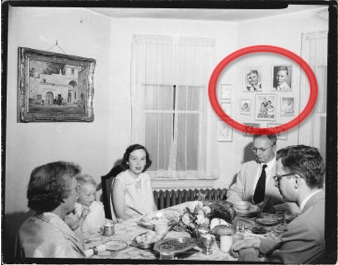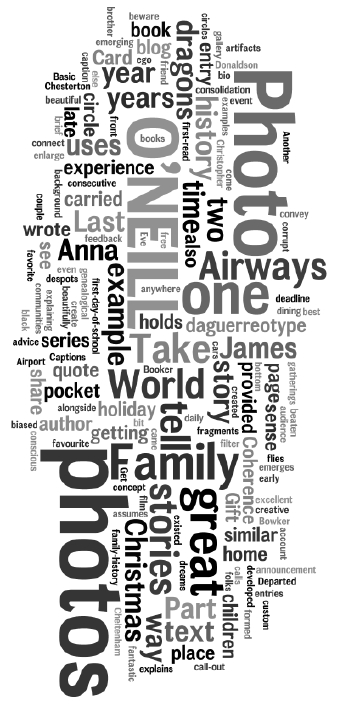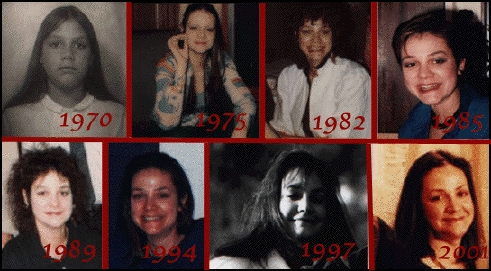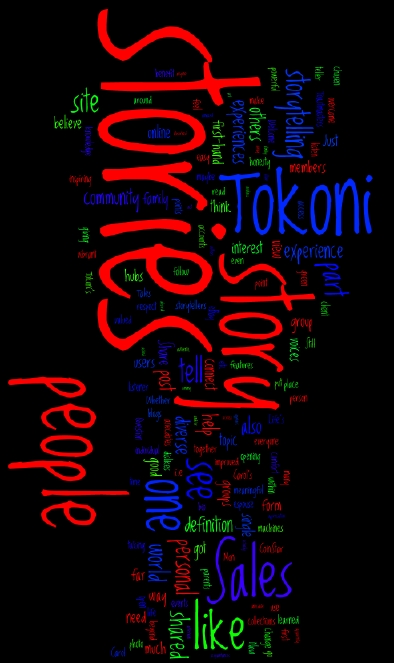… seeing the film Man on Wire last night, in which French wirewalker Philippe Petit did his eight crossings — on a tightrope wire — of the space between the late World Trade Center towers in 1974. The cloud part comes in because it looked like Petit was walking on the clouds. This film tells Petit’s story and underscores what an astonishing act it was for him to wirewalk between those towers. Anyway, here’s this week’s word cloud/tag cloud based on A STORIED CAREER and created at Wordle.net.
Best Ways to Tell Family Stories with Photos
Family history has been on my mind of late. My sister Robin has been doing quite a bit of genealogical research, as well as scanning old photos and artifacts. We have fragments of family-history Web sites online, but I’m getting ready for a major revamp, re-design, and consolidation.
The author of the blog Shades of the Departed (I think the author is KIM O’NEILL) has provided some great tips on ways to use photos to convey family history. O’Neill uses these techniques in making custom heirloom books. Here’s a brief summary of ideas from her excellent and beautifully illustrated blog post:
-
- Repeating photos: “Take photos from the same event or time period at regular intervals, and simply put them next to each other.” The example O’Neill uses is a series of photos of her brother and her sitting on Santa’s lap through the years. I could create a similar montage with the first-day-of-school photos I took of my two children each year — posed in the same place on our front porch. Another example is this series, below, of my best friend, Liz, and her hairstyles through the years.
-
 Photo In A Photo: O’Neill shows a couple of examples of this concept. In one, the subject in a daguerreotype holds a daguerreotype of someone else. In the other, a grandmother holds a portrait of herself when she was younger. My example could come from any one of the photos shot of family gatherings in my grandparents’ dining room. The background in any of these shots is a large gallery of black and white family photos (see red circle in the photo below).
Photo In A Photo: O’Neill shows a couple of examples of this concept. In one, the subject in a daguerreotype holds a daguerreotype of someone else. In the other, a grandmother holds a portrait of herself when she was younger. My example could come from any one of the photos shot of family gatherings in my grandparents’ dining room. The background in any of these shots is a large gallery of black and white family photos (see red circle in the photo below).- Photos with Words. Captions are the obvious way, O’Neill says, but she has created numerous images such as the one of “Anna” in which the “photo her husband James carried in his pocket of Anna while he served in World War II.” O’Neill says she “overlaid a beautiful love letter James wrote to Anna, and included a caption at the bottom of the page explaining James had carried this photo in his pocket.” I’m sure I have a few letters I could do something similar with. O’Neill also uses call-out text. “I take a sentence or two of the text,” she says, “enlarge it, and place it on top of, or alongside, a photo. This is a great way to connect the story and the photo, and also provides a quick visual first-read when there is lots of text on a page.”
Q&A with a Story Guru: Ron Donaldson, Part 4
See Ron’s bio, photo, and Par 1 of this Q&A and Part 2, and Part 3.
Q&A with Ron Donaldson (Question 4):
Q. If you could share just one piece of advice or wisdom about story/storytelling/narrative with readers, what would it be?
A: We all make sense of our world by telling stories. But we experience the world through a lens or filter of what makes sense to us at the time, what John Bowker in his interesting book The Sacred Neuron calls a “Circle of Coherence.” Such circles of coherence are integral to our understanding of how religions have developed and communities and identities are formed.
Stories of the past, i.e., history, are subconsciously and sometimes malevolently biased to paint a picture of what teller assumes the audience want to hear. In short, stories can often tell us more about the person who wrote, re-told, or even translated the story than the experience which the story explains.
The subconscious has its own feedback mechanisms to tell the conscious when it is straying from the ‘norm’ and this emerges as nightmares, dreams and creative thoughts. In early times these would have been giants, dragons and monsters, now they are paedophiles, despots and corrupt politicians.
Christopher Booker in his fantastic book The Seven Basic Plots (Why We Tell Stories) postulates that this is mankind’s way of saying to itself “beware of the emerging ego in yourself.” Great writers and film producers have known this for years from Tolkien to Spielberg but for me it is summed up by my favourite quote of all time from the great GK Chesterton “dragons tell us not that dragons once existed, only that they can be beaten.”
US Airways Launching Annual Holiday Travel Storytelling Contest
For the third consecutive year, US Airways invites travelers to share their favorite holiday travel memories with the rest of the world. The winning submission will take home a $500 US Airways Gift Card to be used anywhere US Airways flies, and two runners-up will take home a $250 and $100 US Airways Gift Card.
Last year, entries ranged from humorous (folks trapped in their cars by their Christmas trees tied to their roof) to poignant (family members getting together for what they knew would be their last holiday) to one of those once-in-a-lifetime moments (the late Luciano Pavarotti performing impromptu outside New York’s LaGuardia Airport.) Last year’s winner came from Cheltenham, Pa., and provided a heartwarming account of Christmas spirit where one pilot’s announcement made a memorable Christmas Eve for all of the children (and grownups too) on his plane.
More here, including entry instructions (deadline is Jan. 2)
Q&A with a Story Guru: Ron Donaldson, Part 3
See Ron’s bio, photo, and Part 1 of this Q&A and Part 2.
Q&A with Ron Donaldson (Question 3):
Q: What people or entities (such as Web sites, blogs, books, organizations, conferences, etc.) have been most influential to you in your story work and why?
A: My top ten in no particular order (to avoid offence):
[Editor’s note: Book and DVD links go to Amazon UK; the same items can presumably be found on Amazon’s US site.]
- The Seven Basic Plots (Why We Tell Stories) — Christopher Booker (2004): This is a massive book, but I just could not put it down. Detailing the plotlines of almost all famous stories it builds and builds a theory of how writers externalise their internal thoughts, worries and concerns into basic archetypal themes and why we must keep our egos in check. This book really did change my life and made me look at all movies and stories in a different light.
- Dave Snowden and Cognitive Edge web site: By far the biggest influence in my approach and understanding, as detailed above. Dave’s approach has always been to share everything, so this site contains all his published materials, links to podcasts and videos and his blog is well worth a regular visit as it contains some of the most thought-provoking ideas, and probably the best example of blogging on the web.
- Soil and Soul — Alastair McIntosh (2001): I met Alastair at a recent “Vine” Environmental Conference and was so taken by his tales of using stories to take on (and win against) corporate power that I bought his book. His intelligent writing, threading in cultural, ecological and some of the best understandings of community I have ever read, are hugely readable, but his explanation of taking on “the dominion system” (“an emergent property of ordinary human failings and commonplace darkness”) is breathtaking, and resonates with every monster, giant and wolf archetypal story you have ever encountered.
- The Workingstories listserv: I registered on this a few years ago, and I get regular emails from other individuals interested in storytelling from across the world on new articles, interesting blog posts or websites and other resources.
- Stephen Denning and Springboard story: I attended one of Steve’s Ark storytelling master classes several years ago, bought the Springboard book (2001) and tried out his advice on a number of projects and presentations, carefully crafting a story, and it worked every time. The real strength for me is how it really cranks up the level of engagement of the audience and does inspire involvement and further action on the part of the listener. Last month I had the surreal pleasure of watching a football match with Steve while eating fish and chips in an English pub.
- The Uses of Enchantment – Bruno Bettelheim (1976): Probably my favourite book (despite the warnings about over-analysis) this details the importance of fairy tales in our lives and the possible psychoanalytical meaning within some of the most well known. Packed full of the how and whys of symbolism, phases of growth and of course the development and control of the ego. I am particularly taken by the idea that fairytales develop the paths for problem solving and making sense of the world in later life.
- The Worldwide Story Work group (on Ning): Very recently set up by a fellow Cognitive Edge practitioner — Shawn Callahan, this is a useful web community, again of worldwide “story workers,” this is a great place to pose questions, connect with people of a similar interests and share ideas, resources etc.
- Surlalune website: Time flies by whenever I visit this amazing website, a huge resource of annotated fairytales detailing history, variants, symbolisms and psychological meaning.
- Sands of Time book — edited by Claire Weaver (2000) — currently being re-printed: This was an English Nature publication that commissioned Joan Barr, a storyteller from Leicestershire, to collect the stories of everyone connected to or who lived near the Satfleetby National Nature Reserve on the Lincolnshire coast. The result was a loosely themed collection of anecdotes that give a real understanding of the reserve and its important to the local population as you read through its amazing tales about smugglers, unexploded bombs, and conservation work. This is an exemplary example of narrative work as a consultation exercise with the use of storytelling sessions in the local pub becoming a constant (and very well received) theme of my storytelling talks.
- Planet of the Apes and its associated commentary on DVD: I first saw this film with my dad when first released at the cinema in 1968 when I was 11, and we sat in awe as the ship flew across the mountains and eventually crash-landed and it has been a constant happy memory and family conversation piece ever since. I was fascinated recently to listen to the DVD commentary that Taylor (Heston) is in almost every scene, and the audience is asked to identify with him, see what he sees and feel what he feels. I have read a lot of the recent research on mirror neurons, which I think give us an insight into part of the reasons why stories and storytelling like this are so effective.
Q&A with a Story Guru: Ron Donaldson, Part 2
See Ron’s bio, photo, and Part 1 of this Q&A.
Q&A with Ron Donaldson (Question 2):
Q: Can you explain your term Knowledge Ecology? To what extent does this discipline relate to storytelling? In line with Dave Snowden, you describe storytelling as a natural or naturalistic way to share knowledge. You could undoubtedly write volumes on this subject, but if it’s possible to sum up briefly …
A: I was constantly rebuked by proper ecologists while working at English Nature because I was abusing and misusing a term (“ecology”) that meant so much to them. I graduated in geology and ecology, but that mattered little to them. The term “knowledge ecologist” arose as a joke to attract interest at a knowledge management conference to which I was invited whereby I would explain that “ideas, knowledge, and communities can be seeded, then their condition monitored and where necessary they should be nurtured or pruned just like the wildlife interest on our Nature Reserves.”
“Knowledge ecologists” already existed as early as 1998 and can be found by googling the term, and Dave Snowden himself was using “ecology” as an alternative to “management” but as I read the books and literature on complexity theory they all kept repeating that the best way to understand a complex system is as an ecology.
More recently I discovered that Victor Shelford, the American zoologist and ecologist, defined “ecology” as “the science of communities,” which I think hits the nail on the head for my use of the term.
As for the storytelling connection, in the natural ecology of our pre-history, it is my belief that three things emerged in humans at a similar time. These were language, storytelling, and the ability of the brain to store and retrieve knowledge in the form of what we now term “a story.” Storytelling is therefore the “natural” way to share knowledge, it is the way our brains process our knowledge, not in the form of expert case studies, bullet-pointed presentations, or lists, but as stories.
Q&A with a Story Guru: Ron Donaldson, Part 1
It’s so much fun to get to know story practitioners through this Q&A series, of which this is the 18th entry. This one is with Ron Donaldson, with whom I became familiar through the Golden Fleece group. See his bio and photo below. His Q&A will appear over the next five days.
 Bio of Ron Donaldson: Ron has spent the last 28 years working for various government departments in England, including Customs and Excise, Nature Conservancy Council and English Nature. Starting off in IT/IS, he has spent the last 10 years as a “cognitive edge” practitioner on an internal-consultant basis, facilitating story-based workshops and giving advice, guidance and training, in “all things narrative,” to a wide variety of projects and initiatives.
Bio of Ron Donaldson: Ron has spent the last 28 years working for various government departments in England, including Customs and Excise, Nature Conservancy Council and English Nature. Starting off in IT/IS, he has spent the last 10 years as a “cognitive edge” practitioner on an internal-consultant basis, facilitating story-based workshops and giving advice, guidance and training, in “all things narrative,” to a wide variety of projects and initiatives.
Ron calls his particular role that of a knowledge ecologist (see Q&A for more on this) and last month he became a self employed consultant. He is currently developing and actively looking for a portfolio of interesting projects/work.
His new blog and website is “the ecology of knowledge”. Here he regularly explores his interests in story, community and complexity.
He is one of the first practitioners in the UK to work with and be able to demonstrate SenseMaker, the new Cognitive Edge narrative software tool.
Q&A with Ron Donaldson (Question 1):
Q. How did you initially become involved with story/storytelling/narrative? What attracted you to this field? What do you love about it?
Q: Back in 1998 Dave Snowden introduced us to his newly developed approach to gathering and making sense of knowledge. As he trained us in the principles and methods of what would become Cognitive Edge, he told us hugely engaging and highly memorable stories about water engineers, taxi drivers and children’s parties.
A: I became fascinated both by the metaphorical meaning and the power of such stories and thought, “I wonder if I could do that for stories related to nature conservation.” I found myself avidly reading books and scouring the web for everything remotely connected to story, community and complexity theory.
I guess it took some courage at first to try out these new methods as serious business tools, but every time I did I came back more and more enthused, as I realised this was so much more productive than my previous approaches of systems analysis and process modelling, but it was the engagement side that surprised me most. People would visibly become friendlier with each other; hardened pessimists would join in and never complain; each time I talked about the approach it would trigger another storytelling initiative or invite for me to get involved.
I loved the fact that using narrative was/is seen as a quirky and alternative approach yet it is based on the most tried, tested and simple to carry out methods available. Nothing excites me more than facilitating a group to tell their stories and watching their different perspectives merge and re-emerge as they make sense of the material as a group.
I now keep a regular watching eye on a wide range of blogs in order to learn that extra nugget about how the mind works and which synapses or hormones are responsible for that feeling of community, or how to structure the perfect story with its archetypal themes and characters. But I am also mindful of the fact that stories like communities are much greater than the sum of their parts, and I might spend my time better reading, listening, and watching good stories than following such a reductionist path in a constant search for each and every component part.
Creating Compelling Interview Stories
It’s great when other career gurus tout storytelling in the job search. I feel like I’m not the only voice crying out in the wilderness. This one is from my colleague Barb Safani via Ezine Articles. Barb and I both serve on the executive board of the Career Management Alliance, and she’s written for Quint Careers.
During a job search, several tools and strategies can be used to weave together a compelling story of your value to an employer. Resumes, interviews, and networking meetings should be rich with memorable information about you and the problems you have solved for organizations. Your story should be so good that the interviewer can’t wait to repeat it to the next person in the hiring chain. Here are some tips for making that happen.
1. Create an exciting resume that the reader just can’t put down.
Don’t just write about job tasks and don’t just list statistics. Build a story around your accomplishments that succinctly communicates the impact you had on an initiative or an organization as a whole.
2. Tell your story with pictures.
Try adding some charts or graphs to your resume to create a visual representation of your impact. For example, if you increased sales 500% over a 5 year period, create a bar graph to show the year over year growth.
3. Add your online stories as well.
LinkedIn, Plaxo, and Facebook profiles are a great way to let other people see who you are both professionally and personally. If used properly, they can help build your credibility, authenticate your passion, and show your human side. Blogging software (try WordPress or Typepad) and microblogging (I like Twitter) can be leveraged quite effectively to create an online presence and voice and establish yourself as an expert in a given area and an engaging storyteller.
4. Showcase samples of your work.
Bring examples of the types of reports, business communications, or design work you do to the interview. Consider including links to websites, photographs, videos, or project prototypes to your resume or portfolio when appropriate.
5. Answer interview questions using the Challenge-Action-Result story format.
Employers are interested in learning about your past successes because they feel that past successes are a good indicator of future success. By describing the challenges you faced, the actions you took to address those challenges, and the corresponding results for the organization, you are more likely to create interest and excitement about your candidacy.
6. Ask questions that invite the interviewer to tell their story.
In order to build a strong rapport with the hiring authority, you need to share information. Asking the interviewer to also share information helps deepen this relationship. Ask what issues the department is struggling with and what types of strategies they have tried in the past to address these issues. Asking questions shows your interest and concern for the company’s problems and also positions you as the right person to address them.
Barbara Safani, owner of Career Solvers, has over 12 years of experience in career management, recruiting, and executive coaching. Ms. Safani partners with both Fortune 100 companies and individuals to deliver targeted programs focusing on resume development, job search strategies, networking, interviewing, salary negotiation skills, and online identity management.
Article Source: http://EzineArticles.com/?expert=Barbara_Safani
Obama Administration Seeks Healthcare Stories
Tom Daschle, President-elect Obama’s point man on the healthcare issue, is discussing the new administration’s early strategy for reforming the healthcare system.
The strategy begins with giving people the chance to highlight their concerns and experiences. Daschle invited people around the U.S. to hold what amounts to house parties from Dec. 15-31. Obama’s transition team will gather the information from those meetings and post the material on its Website. (It appears there is not yet a mechanism to share stories on the site).
By asking anybody and everybody to share their health-care experiences, Daschle is confronting one of the major criticisms of 15 years ago: that the effort to craft former President Bill Clinton’s plan for universal coverage was too secretive.



